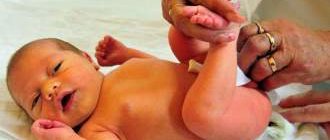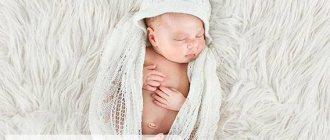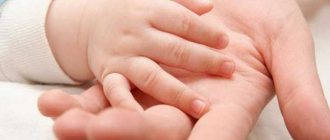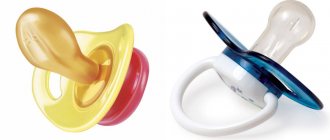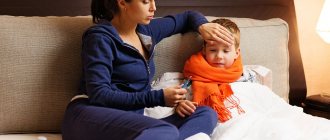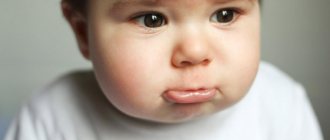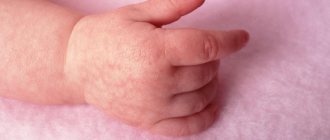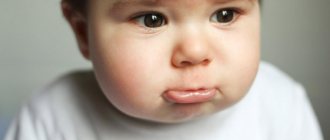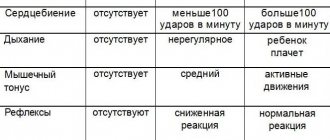November 01, 2016
Averyanova Sveta
Trembling of any part of the body in a newborn frightens and alarms parents. Most often, in infants under one year of age, the chin twitches when crying or nervous tension. Let's figure out together when it's worth sounding the alarm and showing the child to the doctor, and in what cases there is no point in worrying for mothers.
Causes
Provoking factors for tremor in infants are divided into physiological (normal) and pathological (painful, unhealthy). If a child’s chin, arms, legs, and head shake from birth to 3–4 months, this is normal; the symptoms do not require treatment.
Over time, the nervous system will learn to control movements, control emotions, and the tremor will pass. The persistence of twitching in a later period and tremors at rest signal pathological causes that require diagnosis.
Physiological
The baby's chin sometimes shakes when he cries, if he heard a sharp sound, feels hungry, touched hot or too cold water, or the parents made a sudden movement. The reasons for this reaction of the facial muscles to stimuli are:
- Instability of the newborn's central nervous system. The baby cannot control emotions. Trembling of the chin or lower lip occurs due to stress or as a preparation for crying; from harsh light or sound, the baby may still blink frequently and shake his lips. This symptom is also typical for adults who have experienced shock, great joy or grief.
- Immaturity of the endocrine system.
Any emotional overexcitation provokes the release of hormones into the blood. Norepinephrine causes muscle tremors. By the age of one year, the functioning of the adrenal glands is normalized. - Prematurity. Tremors are more common in children born prematurely. If development proceeds at a normal pace, the trembling will stop by 6–12 months.
- Muscle trembling from tension, sucking. When a baby yawns heavily or sucks on a breast or bottle for a long time, the facial muscles tense and a short tremor may occur. This does not mean that the child is sick.
On a note! Cramps of the lips and chin are common in absolutely healthy children after sleep. An infant may awaken abruptly from noise or colic, or be frightened by something during sleep. This is a normal phenomenon; if the tremor goes away after 20–30 seconds, the condition is not regular.
How often does your child's chin shake during the day?
- 2-3 times a day 40%, 153 votes
153 votes 40%153 votes - 40% of all votes
- 3-4 times a day 30%, 114 votes
114 votes 30%
114 votes - 30% of all votes
- Very often 20%, 77 votes
77 votes 20%
77 votes - 20% of all votes
- Once a day 11%, 42 votes
42 votes 11%
42 votes - 11% of all votes
Total votes: 386
26.12.2018
×
You or from your IP have already voted.
Pathological
With pathological tremor in newborns, the chin, head and limbs tremble. The totality of symptoms, their intensity, duration, twitching for no apparent reason is a serious reason to consult a neurologist at any age. Pathological causes of tremor include:
- intrauterine infections;
- threats of miscarriage during pregnancy;
- sepsis;
- placental abruption;
- prolonged labor;
- intoxication in the womb;
- fetal hypoxia;
- birth injuries;
- intracranial hemorrhage due to trauma;
- vitamin deficiency, lack of calcium, glucose, magnesium;
- withdrawal syndrome in a pregnant woman after withdrawal from alcohol and drugs;
- blood poisoning;
- muscle hypertonicity.
The disease develops in a baby immediately after birth or in the womb. You cannot cure tremor on your own; seek medical help.
On a note! It is interesting that the chin and limbs of 2-3 month old children can shake not only from negative emotions, but also from joy, delight and interest.
conclusions
Tremor occurs in every second newborn. Up to three months this is quite normal. Most often, this phenomenon is observed in children born prematurely. It happens that a newborn's chin shakes when crying. There is no need to be afraid if the tremor lasts a few seconds.
In pathologies, tremor is observed in a calm state, lasts quite a long time, intensifies, becomes more intense and affects the baby’s head, arms and legs. Only a pediatrician or pediatric neurologist can diagnose the pathology and determine treatment. The doctor will recommend a massage complex to the mother that will help relieve the baby from the disease.
How you can help your child cook more confidently and get rid of chin tremor is described in the video:
When to see a doctor
Medical attention is required for children with trembling of the chin and other parts of the body if the culprits of the tremor are diseases of the central and peripheral nervous system. The mother needs to carefully observe the child, even make notes about the time and cause of the chin trembling.
To understand what nature the tremor has (physiological or pathological), answer 5 questions based on observations of the baby:
- Child's age? Tremor up to 3-4 months is not diagnosed as a disease. You should consult a doctor after this age, if you regularly observe a pathological symptom, an increase in the number of causeless tremors and their intensity.
- How long does the tremor last? If the shaking is intense, lasts more than 30 seconds, the symptom repeats daily, the baby needs the help of a specialist.
- What's trembling? If in the first months of life only the chin shakes from stress, while other parts of the face and limbs remain calm, parents should not be nervous. Closer to the year, the unpleasant symptom for mom will pass. If a two-month-old baby shakes his entire head, chin and limbs at the same time, you should not postpone a visit to the doctor.
- Is there a reason for chin trembling? Anxiety should be caused by tremor at rest, for no apparent reason (fright, crying, hunger, bathing, etc.). If the tremors have provoking factors, the attack does not last long and is repeated less frequently with age, the help of a pediatrician will not be required.
- Is trembling accompanied by other signs of illness? Contact a neurologist or pediatrician if, during tremors, the baby's facial skin turns blue and becomes covered with perspiration, twitching begins immediately after feedings, tremors of the head and limbs are asymmetrical, and the baby has large tremors.
In this video, you will learn even more about chin tremors from your pediatrician.
When should you see a doctor?
If the baby’s chin begins to tremble in a state of complete rest, then we are talking about hypertonicity. This is a special condition in a child, which is characterized by overstrain of the baby’s muscular system.
In this case, the child must be shown to a specialist. Only a doctor, after examining the newborn, will be able to give certain recommendations on how to relax the child’s muscles.
As a rule, the child is prescribed several courses of professional massage, as well as a complex of therapeutic exercises. In addition, it is recommended to take warm baths with the addition of various herbal infusions that have soothing properties.
The next condition that poses a danger to the child is the spread of tremor to the entire head. The baby also needs to be shown to a neurologist if the tremors persist after the child is more than three months old. Such symptoms may indicate that the baby has diseases of the central nervous system.
The next reason for the development of chin tremor in a child is stressful situations experienced by a woman while carrying a child. Norepinephrine (stress hormone) passes from mother to child, causing deviations in the development of the nervous and endocrine systems.
Post-mortem hypoxia (lack of oxygen) is also a fairly common cause of the pathological condition, since when there is insufficient oxygen supply to the brain, its functioning is disrupted.
What can be done
When the baby's chin and limbs shake, and his lips tremble, frightened mothers forget what to do in this situation. Parents themselves experience stress and panic. In fact, preventive measures for muscle spasms are simple.
If your baby has been twitching his head and chin since birth, but most of the time he is calm and happy with life, you need to minimize the number of shocks. At the same time, keep in mind that the child experiences stress from negative and positive emotions. The task of parents is to create a harmonious, calm environment in the house, to protect the baby from provocateurs of an outburst of feelings of a different nature.
Proceed according to the following plan:
- Analyze to what everyday moments the baby reacts violently (cries, is very happy, is afraid) and why this happens. Perhaps the cause of stress is the presentation of a new toy, too strong emotions of the mother, loud laughter of parents or screams.
- Carry out daily hygiene procedures and get ready for a walk calmly. Take your time and don't stress yourself out first. If possible, minimize the number of nervous breakdowns and disputes with relatives. Remember that the mood of the family is transmitted to the baby.
- Do not breastfeed when your baby is excited. When breastfeeding, the mother transfers her hormones to the baby, including norepinephrine. Increased levels of this substance in the blood provoke nervous movements of the chin and head in infants.
- Create a daily routine and strictly follow the plan.
- Give your child a relaxing massage and exercises to relieve hypertension.
- Bathe with soothing herbs. Add decoctions of chamomile, string, and oregano to the water.
- After six months, if the tremors have not stopped, consult a doctor. A neurologist will make a diagnosis based on examination and hardware studies. If necessary, he will prescribe medications: Pantogam, Glycine, Mydocalm.
What if your chin and legs tremble?
The famous pediatrician and teledoctor Evgeniy Olegovich Komarovsky is often asked what to do if a baby’s chin is shaking and an arm or leg is connected to the tremor? The pediatrician advises not to worry if the baby otherwise behaves normally: sleeps well, eats, smiles, and develops correctly in basic indicators.
It is impossible to make a diagnosis based on one symptom - irregular tremor of parts of the body or face - in a young child.
To suspect a pathology, more compelling reasons and regular manifestations of symptoms of the disease are required.
If you do not observe other signs of central nervous system diseases, except for tremor from fear or joy, and the neurologist has prescribed medication, consult another doctor. If trembling of the lips, chin, or limbs is combined with other clinical symptoms of neurological pathologies, appears at rest, and does not disappear after 4–6 months, you should not hesitate to seek medical help.
Why does a newborn's chin shake?
Physiological tremor
The main cause of tremor can be considered to be incompletely refined functions of the central nervous system, and a concomitant factor is an incompletely formed hormonal system. The hormone norepinephrine, which is produced by the adrenal glands during stress, is responsible for muscle contraction. Considering the fact that in newborn children the adrenal glands are not fully developed, even with the slightest excitement they release a huge dose of norepinephrine into the blood, which causes tremors of the baby’s chin, lips and hands.
Note! In premature babies, these phenomena are much more pronounced, because their central nervous system is in a more underdeveloped state compared to babies born at normal terms. It should be especially noted that after birth, the final formation of the nervous system lasts much longer than in the mother’s womb.
Twitching of the chin and arms, which last a short time, also appears as a result of the baby’s expression of emotions, both negative and positive, that is, with any emotional overstimulation. Even when feeding or bathing, despite the purely pleasant sensations, a similar effect is observed quite often. Newborn babies, exploring the world around them, constantly learn something new, which in itself is a little stress, and its fragile nervous system exhibits a violent reaction in the form of crying and tremors. Any discomfort, pain (for example, with gas in the stomach), hunger, heat, cold, and even a wet diaper or basic fatigue can cause crying and muscle twitching.
In principle, the reasons causing the condition in question can be listed ad infinitum, because the nervous system of a little person is very mobile, active and extremely easily excited. This condition goes away after reaching three months of age; in premature babies, the process of strengthening the nervous system is slightly delayed and requires a little more time. Therefore, if you notice signs of tremor in your baby, you should not panic.
Tremor of the chin in various pathologies
Chin tremor in infants can also occur with various pathologies. The main causes of pathological tremor are disorders of the brain and central nervous system:
- Their appearance can be caused by an infection, in most cases intrauterine.
- The brain also suffers as a result of birth injuries or oxygen starvation resulting from entanglement of the fetus with the umbilical cord, placental abruption, bleeding and other factors.
- Such risk factors include the threat of miscarriage, polyhydramnios, rapid labor and weak labor.
- If the expectant mother suffers nervous stress, then norepinephrine produced in her body can enter the blood of the fetus through the umbilical cord and provoke disturbances in the development of its endocrine and nervous systems.
Relaxing massage
Kneading and stroking the body is beneficial for all infants. Massage helps relieve colic, improves the baby's immunity, and brings mother and child closer together emotionally. You can carry out the procedure yourself or invite a specialist.
Preparation
Massage should be a source of positive emotions. During the kneading process, muscles relax and nerves calm down. The effectiveness of the procedure largely depends on the preparatory stage.
- Ventilate the room. The temperature should be at least 24°C so that the crumbs do not freeze.
- Remove long nails and hangnails from your hands so as not to scratch your baby’s body.
- Remove rings and bracelets.
- Wash your palms with soap and warm them.
- Place a thick blanket on the changing table and crib.
- During the massage, talk tenderly to the baby and sing.
- Carry out the procedure before bed, after a bath.
- Do not massage if the baby is in a bad mood or is sick.
- Strip the baby naked.
- Use oil (vaseline or massage oil).
- Continue the procedure for 10–15 minutes.
